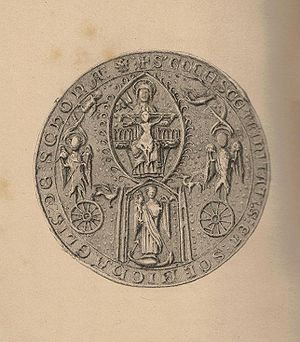- Abbot of Scone
-
The Abbot of Scone, before 1163 x 4, Prior of Scone, and then by the beginning of the 16th century, the Commendator of Scone, was the head of the community of Augustinian canons of Scone Abbey and their lands. The priory was established by King Alaxandair mac Maíl Choluim (Alexander I) sometime between 1114 and 1120, and was elevated to the status of an abbey in 1163 or 1164. The abbey was turned into a secular lordship for William Ruthven, 1st Earl of Gowrie in 1581, but was forfeited when the earl was executed in 1584, given to William Foularton in the same year, but restored to the earl's son, James Ruthven, 2nd Earl of Gowrie. An independent secular lordship was established for David Murray in 1608.
Contents
List of priors of Scone
- Robert (I), 1114 x 1120-1127
- Nicholas, 1127-1140
- Dionysius, 1140 - 1142 x 1147
- Thomas, 1150-1154
- Isaac, 1154-1162
- Robert (II), 1162
List of abbots of Scone
- Robert (II),[1] 1163x1164-1186
- Robert (III), 1186-1198
- Reimbald, 1198-1206
- William, 1206 x 1209-1225
- Robert (IV), 1227
- Philip, 1230-1242
- Robert (V), 1240-1270
- Nicholas, 1270-1273 x[2]
- William, 1273 x 1284
- Hugh, x 1284-1287
- Thomas de Balmerino, 1291-1312[3]
- Henry Man, 1303-1320
- Simon, 1325-1341
- Adam de Crail, 1343-1344
- William, 1354-1370 x 1391
- Alexander, 1370 x 1391-1412 x 1417
- Alexander de Balbirnie, 1412 x 1417-x1418
- Adam de Crannach (Aberdeen), 1418-1432
- John de Inverkeithing, 1432
- William de Skurry, 1435-1439
- James Kennedy, 1439-1447[4]
- George Gardiner, 1445-1447
- Thomas de Camera,[5] 1447-1458
- John Crambe, 1465-1491
- David Lermonth, 1492-1496
- Henry Abercrombie,[6] 1492
- James Abercrombie, 1492-1514
List of commendators
- Alexander Stewart de Pitcairne, 1518-1537[7]
- Patrick Hepburn,[8] 1538-1571
- William Lord Ruthven, 1571
- John Ruthven, 1580
- William Ruthven, 1st Earl of Gowrie, 1581-1584
- William Foularton, 1584
- James Ruthven, 2nd Earl of Gowrie, 1587-1588
- John Ruthven, 3rd Earl of Gowrie, 1592-1600
- David Murray (later Lord Scone and Viscount Stormont), 1608
Notes
- ^ Previously prior of Restenneth; became prior of Scone in 1162, and continued as abbot after promotion of the priory to an abbey.
- ^ Became bishop-elect of Caithness in 1273, and although the election was cancelled, he may have resigned his abbacy. His successor William occurs in a document of the period, but the dating is uncertain.
- ^ Imprisoned by the English government; Henry Man became abbot in his place, but he was still claiming the abbacy, and managed to get back in office in 1312.
- ^ Commendator; granted comment along with the bishopric of Dunkeld, which he held until his translation to St Andrews.
- ^ Previously prior of May.
- ^ Previously abbot of Cambuskenneth.
- ^ Also commendator of Inchaffray.
- ^ Previously prior of St Andrews.
Bibliography
- Cowan, Ian B. & Easson, David E., Medieval Religious Houses: Scotland With an Appendix on the Houses in the Isle of Man, Second Edition, (London, 1976), pp. 97-8
- Watt, D.E.R. & Shead, N.F. (eds.), The Heads of Religious Houses in Scotland from the 12th to the 16th Centuries, The Scottish Records Society, New Series, Volume 24, (Edinburgh, 2001), pp. 198-202
See also
- Viscount Stormont
- Stone of Scone
Archbishops Bishops Archdeacons Abbots Arbroath · Balmerino · Cambuskenneth · Coupar Angus · Crossraguel · Culross · Deer · Dercongal (Holywood) · Dryburgh · Dundrennan · Dunfermline · Fearn · Glenluce · Holyrood · Inchaffray · Inchcolm · Iona · Jedburgh · Kelso (Selkirk) · Kilwinning · Kinloss · Lindores · Melrose · Newbattle · Paisley · Saddell · Scone · Soulseat · Sweatheart · TonglandPriors Ardchattan · Beauly · Blantyre · Canonbie · Coldingham · Fogo · Fyvie · Inchmahome · Lesmahagow · May (Pittenweem) · Monymusk · Oronsay · Perth · Pluscarden · Restenneth · St Andrews · Strathfillan · St Mary's Isle · St Serf's Inch, Loch Leven · Urquhart · WhithornCategories:- Canonical abbots and priors
- Christianity in medieval Scotland
- Lists of abbots
- Scottish abbots
- Scotland-related lists
- 1110s establishments
- 1608 disestablishments
Wikimedia Foundation. 2010.


